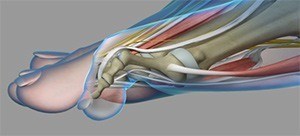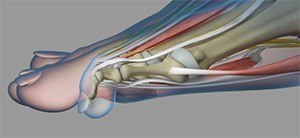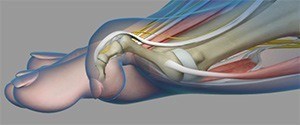Toe Deformities
Toes are important to our feet as they help in walking, balance, weight-bearing and other activities. Deformities in the toes can lead to pain and problems in movement. Some of the common toe deformities include:
- Hallux Valgus: Halluxvalgus, commonly called a bunion is a common toe deformity in which thegreat toe is shifted laterally and lies over the second toe. A boney bumpforms at the base of the toe. A fluid filled sac (bursa) may form by thecontinuous irritation and inflammation of the bunion when it rubs againstyour shoes. The factors that cause hallux valgus include structural footabnormalities (which may or may not be congenital) and wearing narrowshoes that cause the toes to curl or fold. Hallux valgus is usuallyassociated with pain, swelling, redness, thickening of the skin, callousesor corns. Treatment depends on the severity of your condition and mayinvolve conservative or surgical treatment. Your doctor may recommendshoes that have a good amount of space for the toes with no heels. Shoeinserts may help to prevent its progression. Surgery may be recommendedonly in severe cases,and involves removing the swollen tissue, straightening and realigning thebones of the foot, or permanently fusing the affected bones.
- Hammertoe:

Hammertoe is a deformity in which there is downward bending of the middle joint (proximal interphalangeal joint or PIP joint) of the toe. Although it can affect any toe, hammertoe most commonly forms in the second toe. It may be present at birth or result from wearing shoes that are too tight, which forces the toe to bend forward. Over time, you may lose flexibility of the toe and not be able to straighten it. With constant rubbing from ill-footing footwear, the top region of the toe may form a corn and the sole may form a callus. Wearing shoes and walking usually becomes painful. Hammer toe can be treated by straightening and splinting the toe, performing stretching exercises or undergoing surgery for severe cases.
- Mallet Toe:

Mallet toe refers to the downward bending of the joint closest to your nail (distal interphalangeal joint or DIP) giving it a mallet-like appearance. It develops with constant usage of tightfitting and high-heeled shoes. Mallet toe most commonly forms in the second toe. Corns or calluses may develop over the deformity as a result of constant friction with footwear, and you may find it difficult to straighten out the joint. Mallet toe can be treated by changing your footwear to one that allows ample amount of space for your toes, wearing shoe pads or inserts to realign your toe, stretching exercises or in severe cases, surgery.
- Claw Toe:

Claw toe is a deformity characterized by the abnormal bending of the toe in an upward direction at the joint close to the ball of your feet, and downward direction at the joints closer to the nail, curling up like a claw. It occurs commonly due to tight shoes that squeeze your toes, or may sometimes be associated with neuromuscular conditions. With constant rubbing of the deformed toe against your shoes, the affected claw toe can form corns. Claw toe is treated with stretching exercises, wearing roomy shoes or surgical correction.
- Curly Toe: Curlytoes are congenital curling of the toes, affecting the third, fourth andfifth toes of one or both feet. It is caused by the tightening of thetendon that runs below the toe, pulling the tip of the toe towards thesole and under the next toe. The skin on the sole of the foot may hardenand shoes may not fit properly. Curly toe is treated with surgery, wherethe tendon is released.
- Polydactyly: This is agenetic condition characterized by more than five fingers or toes. Theextra digit may be poorly developed or complete with muscle, bone, nervesand blood vessels, and sometimes even functional. It may occur inassociation with other congenital anomalies or as an isolated problem. Ifthe extra digit does not cause any problem, it may be left alone withoutany treatment. Some may prefer to remove the extra digit for aestheticreasons or when an extra toe causes difficulty in wearing shoes. Surgeryis usually done after the age of 9-12 months.
- Syndactyly: Syndactylyis an inherited condition characterized by the presence of fused digits,and may occur along with other congenital anomalies or as an isolatedproblem. Joined toes rarely cause problems and usually do not need anytreatment, but surgery is recommended when the condition interferes withnormal functioning of the digits.
- Bunionette (Tailor bunion): This is a boney bump that forms at the base of the little toe. It may be caused by an inherited structural deformity where the joint at the base of the toe shifts outward or a bone spur (outgrowth) causes constant rubbing against the shoe. Bunionettes can be painful and cause discomfort while wearing shoes. Padding, orthotics and other shoe modifications can provide relief. If this does not help, surgical correction will be needed.

 Menu
Menu




